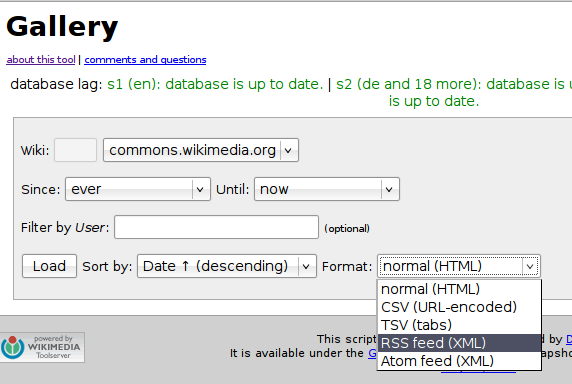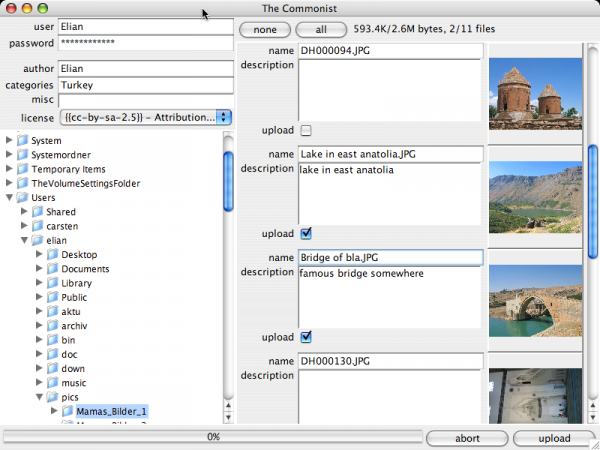Wikimedia Commons
Tools and resources
Your personal gallery
![]()
When you view your user page or user talk page (both of which are linked in the top right-hand corner when you're logged in), you'll see these tabs at the right-most position -- next to the "watch" or "unwatch" tab. Clicking on "gallery" will lead to a page that gives you a visual overview of your uploaded files, from your most recent to your oldest. From this view you can also look at the Gallery of any other user just by changing the "User" field.

You can also produce an RSS or Atom feed of your uploads. This can be a useful link to give to others who want to follow your work, or a way to follow other people's work.
- Web interface: http://toolserver.org/~daniel/WikiSense/Gallery.php
Alternate upload forms
If the default upload form annoys you as being unnecessarily fiddly, there are alternatives. One is linked from Commons:Upload - the basic upload form. The required fields are not explained in the same detail, but once you've used the detailed form a few times you may find this form faster to deal with.
It's also possible to replace the "upload file" link in the navigation menu so that it links directly to a form of your choice. It's possible to install a JavaScript script so that your link goes directly to a very simple form. Follow the instructions at http://commons.wikimedia.org/wiki/MediaWiki_talk:Replaceuploadlink.js . (If the link doesn't change immediately, trying logging out, clearing your browser cache, and logging back in.)
Bulk (batch) uploading
If you have a lot of files to upload you'll soon find the single-file-upload interface tiresome, especially if they contain much the same metadata.
Graphical tools
There are currently two GUI tools. They are both developed by members of the Wikimedia community and are licensed under the GPL (the same license as Wikipedia/MediaWiki.WikimediaFoundation).

Commonist requires Java. Java is available on Linux, Windows and Mac OS X operating systems. Commonist installation and use instructions can be found at http://commons.wikimedia.org/wiki/Commons:Tools/Commonist .

Commonplace requires .NET 2.0+/Mono framework. .NET is available for Windows and Mono is available for Linux, Windows and Mac OS X. The program can be downloaded from http://code.google.com/p/wikimediacommonplace/ and further information can be found on-wiki at http://commons.wikimedia.org/wiki/Commons:Tools/Commonplace .
Command-line tools
If you're comfortable with editing text files to indicate your preferences, you may prefer a command-line script. Linux and Mac OS X users can run such scripts directly; Windows users will need to install Cygwin.
- Bulk upload script written in Perl, with instructions: http://commons.wikimedia.org/wiki/Commons:File_upload_service/Script .
- The Pywikipediabot framework is written in Python. If you have that installed, you can use these instructions: http://commons.wikimedia.org/wiki/Commons:Tools#Python_Wikipedia_Bot
The Wikipedia/MediaWiki.WikimediaFoundation API currently lacks write (and thus upload) capability. When this capability is added to the API, it is likely that bulk upload tools will become much more prevalent.
Finding categories
A necessary component of good uploading practice is locating relevant descriptive categories. A tool has been written specially for this purpose, called CommonSense. To find potential categories for files you haven't yet uploaded, enter your keywords into the "Keywords" field, then click "Find categories". Suggestions will appear at the bottom of the page (it generally takes a few second to process a request).
Note that despite its name, the categories it suggests are often not very good!
- CommonSense instructions and translations: http://meta.wikimedia.org/wiki/User:Duesentrieb/CommonSense
- CommonSense web interface: http://toolserver.org/~daniel/WikiSense/CommonSense.php
Once you have spent some time exploring Wikimedia Commons' category system (the easiest way to do this is click on the "Categories" links that appear at the bottom of image pages), you will probably find it easier to locate categories yourself. On the main page several dozen high-level categories are listed on the right. A special page called CategoryTree is very useful for quickly "drilling-down" through existing categories to find the most specific one relevant to you.
Getting help
If you ever have a question you can't find the answer to, don't panic. The great thing about a wiki is that every action can be undone, so there's no need to worry about making a mistake. The other great thing is that there's always lots of people around happy to help!
Requesting help on-wiki is usually the most reliable method.
On-wiki
- http://commons.wikimedia.org/wiki/Commons:Help_desk
- http://commons.wikimedia.org/wiki/Commons:Village_pump
- http://commons.wikimedia.org/wiki/Commons:Administrators'_noticeboard
These three notice boards are the main pages for community communication. Generally you should start at the Help desk, and move to the Village pump if you don't get a satisfactory answer. You can jump straight to the Administrators' noticeboard if you are having an ongoing dispute with another user that doesn't seem like it can be easily resolved.
Whichever board you post to (don't post to all three at once!), be sure to sign your post with your signature (write "~~~~" at the end - four tildes), and add the page to your watchlist. Check back in a day or two to see if anyone has responded.
IRC
If you've got a short, quick question and would like a faster response, you can try IRC (Internet Relay Chat). IRC is similar to IM (instant messaging). Keep in mind what you say on IRC is not private. You may also get a more flippant response than you would on-wiki.
You usually need to download an IRC client to participate. ChatZilla is an IRC client available as a Firefox browser extension. If you just want to try IRC once, there is a web-based interface available at http://chat.wikizine.org/ -- but a separate IRC client is really a much better option.
Mailing lists
If you like email, you might want to subscribe to the commons-l mailing list. This list is often used to float new ideas and share related news, but if you have a nagging concern, you might find sharing your complaint prompts some new ideas on how to approach it. Necessity is the mother of invention, after all.